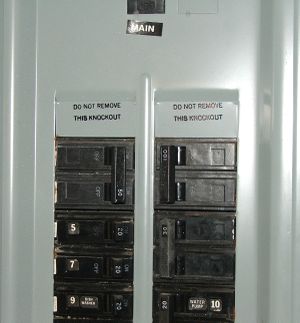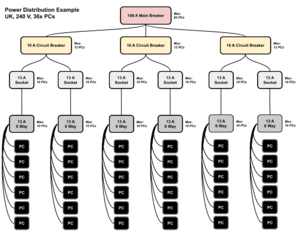Power
Fundamental to planning your event is finding out how many computers or consoles you can support. This requires some investigation of your venue's power supply, and planning how you distribute the power to attendees.
Contents
Venue Distribution Board
First, find out what the total available supply is at your venue by finding the venue's power distribution board, also known as panelboard, breaker panel, electric panel, fusebox or consumer unit.
The distribution board will typically have several circuit breakers (or in older venues, fuses), consisting of:
- many low current breakers, each supplying a "circuit" or "ring main", typically consisting of a group of wall sockets
- a single high current "main" breaker or switch, supplying all of the above low current breakers
All the breakers will be marked with the maximum current in Amps (A) that they will allow to pass before shutting off the supply for safety.
Absolute Maximum Current
The value of the single high current breaker or switch described above is the maximum current that can be safely provided to all equipment connected to the distribution board, and therefore the maximum number of computers or consoles you can support. Check this against the table below, but be aware that this does not account for other equipment at the venue. To factor this in, see Advanced Power Calculations.
If you find that your event will have close to or more than the number of computers or consoles the venue can support, you have these options:
- Reduce the number of attendees
- Disconnect / exclude unnecessary equipment at the venue
- Request that the venue improve their electrical supply
Distributing Power
If your venue's supply is adequate for your event, you will need to spread the equipment evenly, logically and safely across the available circuits.
Circuit Breakers
The current rating of each of the low current breakers described above will tell you the maximum current that can be safely provided to the group of sockets that it supplies. Label sockets with the breaker they are supplied by to ensure you do not overload a breaker, and to simplify troubleshooting:
- Plug in a lamp into a socket which you don't know the corresponding breaker
- Switch off each breaker in turn until the lamp switches off
- Once you have discovered the breaker that supplies the socket, label the socket with the same label as the breaker
- Repeat this process until all sockets are labelled
Sockets
Electrical sockets have a maximum current rating they can safely supply, and the rating differs by socket type and country.
Power Extensions
As with circuits and wall sockets, extension cables will have a maximum current rating they can safely supply, which will be displayed on their casing.
Check the table below for how many computers or consoles can be connected to each of your circuit breakers, sockets and power extensions.
| Supply (Volts) | Circuit Type | Circuit Rating (Amps) | Circuit Rating (Watts) | Maximum Supported # of Computers |
| 230 V
Europe, Middle-East, Africa, Asia, & Pacific |
IEC C13/C14 Cable
UK BS1363 Budget Power Extension Reel |
10 A | 2300 W | 8 |
| UK Plug Socket (BS1363)UK BS1363 Extension | 13 A | 2990 W | 10 | |
| EU CEE 7/3 & 7/4 "Schuko" Plug Socket16 Amp Circuit Breaker | 16 A | 3680 W | 12 | |
| 32 Amp Circuit Breaker | 32 A | 7360 W | 25 | |
| 63 Amp Circuit Breaker | 63 A | 14490 W | 50 | |
| 100 Amp Circuit Breaker
100 Amp Main Switch |
100 A | 23000 W | 80 | |
| 115 V
North & Central America |
10 Amp Circuit Breaker | 10 A | 1150 W | 4 |
| 15 Amp Circuit Breaker
USA NEMA 1-15 & 5-15 Connector USA NEMA 1-15 & 5-15 Power Extension |
15 A | 1725 W | 6 | |
| 20 Amp Circuit Breaker | 20 A | 2300 W | 8 | |
| 30 Amp Circuit Breaker | 30 A | 3450 W | 12 | |
| 50 Amp Circuit Breaker | 50 A | 5750 W | 20 | |
| 100 Amp Circuit Breaker | 100 A | 11500 W | 40 |
For consoles, multiply the supported number of computers by 1.4, as consoles use less power than computers.
Please note: These numbers are approximate and do not take other equipment into consideration, so to be sure you should do your own measurements and calculations.
Planning Distribution
Now that you know how many computers or consoles are supported in each part of your distribution (circuit to socket to power extension), plan how you will distribute the power to all your equipment without overloading any part of the distribution.
Plan from the main breaker onwards, taking into account the "bottlenecks" along the way. You may need to run extensions from other parts of the venue to make use of all the power available without overloading any circuit breakers.
The number of computers connected should never exceed the rating of any part of their distribution, otherwise fuses will blow, breakers will trip, and fires could start.


